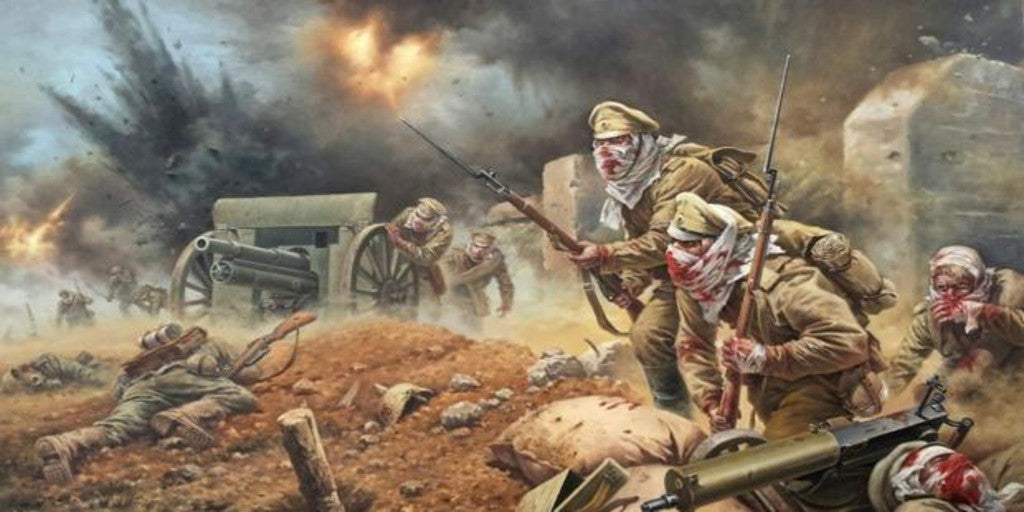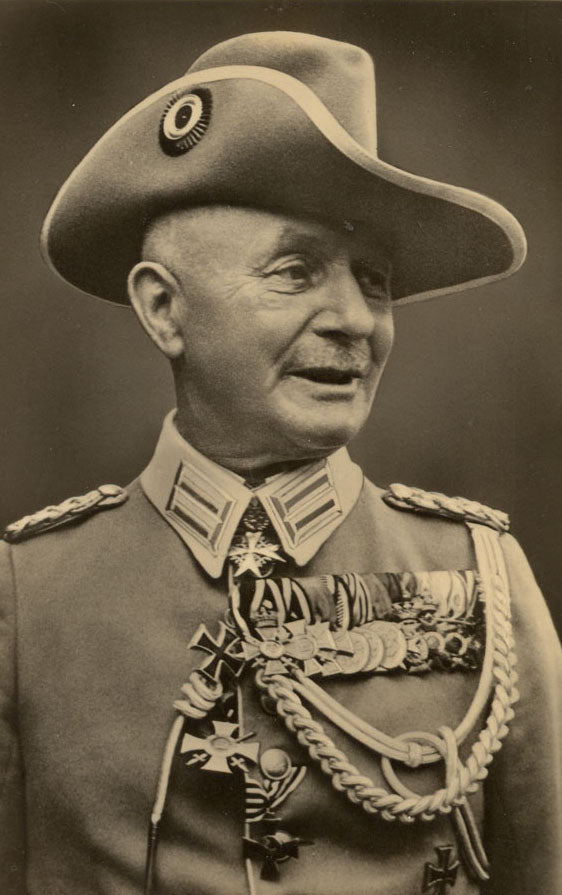
Warrior Wednesday: Attack of the Dead Men
During the Great War there is an often forgotten story of an impenetrable defense on the Eastern Front. A stalwart defense that turned into a counter-attack. A counter-attack that would go down in history as the “Attack of the Dead Men” which sounds metal as fuck.
September 1914. A few thousand Imperial Russian and Polish defenders, a mix of about 500 reservists from the 226th Infantry Regiment Zemlyansky and 400 volunteer militia led by Maj. Gen. Nikolai Brzhozovsky held a small, outdated bastion known as Osowiec Fortress. The stronghold's location was of strategic importance to the allied powers. A vast expanse of swampland surrounded it. The only way to move vehicles and supplies was through the pass that was guarded by Fortress Osowiec. This position also defended a railway. Whoever controlled the fortress could resupply forces all across the Polish salient. Fortress Osowiec was old and critically outdated, it was designed to withstand the artillery barrages of field pieces from the 1870s. Its soldiers were not crack frontline infantry. These defenders faced 40 infantry battalions of the German 8th Army led by Field Marshal Paul von Hindenburg. The 8th army had hundreds of artillery pieces, including massive 203mm Siege guns.
In an effort to strengthen the old Fortress’s defenses, Brzhozovsky had his men establish a textbook “Defense in Depth” strategy. two defensive trench lines were established to stop an enemy attack before it even reached the fort. The first line was a shallow trench network with barbed wire at the front. The second defensive line, which had much deeper trenches as well as more barbed wire and areas for machine gun emplacements, would allow soldiers to break contact and fall back to more defensible positions. If the Germans penetrated the two trench lines then they'd still have to face the battlements that made up the fort's outer defenses. Here Russian soldiers could easily kill the Germans from relative safety. If the attackers made it inside then they'd still have to fight in deadly close quarters combat.
In late September, The German 8th Army launched a full court press of Infantry frontal assaults under the cover of accurate and deadly Artillery fire. The Russian counter battery fire stopped the German assault in its tracks. The next day Members of the 226th sallied out to conduct flanking attacks that quickly forced the German artillery to relocate far back enough that it couldn’t target the fortress or the surrounding trench lines. They had beaten back the Germans and earned a reprieve. After countless small raids and skirmishes that slowly drained away at the defenders’ supplies, the German army sent a representative to try to bribe Gen Brzhozovsky into surrendering. He told them if they wanted Fortress Osowiec they’d need to step the fuck up and kill him first.
The Germans launched another attack on Feb 3rd 1915. For five days the defenders of the first trench line weathered the storm of lead and shrapnel and beat back dogged enemy assault after assault. On the 6th day they withdrew to the second network of trenches. While this preserved the lives of the defenders this also allowed the Germans to bring up their heaviest siege guns again. At the second trenchline the Russians and Poles held for another two days and cost the Germans hundreds of lives. The German heavy artillery, which ranged in caliber from 100mm to new 420mm siege guns began to pound the fortress and surrounding trenches with brutal fire around the clock. Every 4 minutes 360 artillery pieces would fire a salvo at the defenders. During the initial week-long barrage, the siege guns launched 250,000 rounds while the German Light artillery sent over 1 million rounds at the defenders.

420mm(42cm) Siege Howitzer
Upon hearing about the devastating artillery barrage, the Russian High command requested the Impossible. They ordered the defenders to sell their lives dearly and hold their ground for 48 hours so that civilians in the surrounding areas could be evacuated.
The 226th held their ground for over 6 fucking months. For 190 days the defenders held their ground in the face of overwhelming indirect firepower and infantry assaults. Each day they survived was a huge morale boost to the Russian Army across the battlefields of the Eastern Front. The Germans needed to break the Russians' spirits.
Fortress Osowiec was so damaged that movement between the fortress buildings was impossible because of the rubble, units were cut off from each other and lower leadership needed to step up in the absence of orders.
Unable to break the back of the Russian Defense, von Hindenburg rallied his men for one last attack. 14 infantry battalions, a battalion of sappers, 30 siege guns and 30 batteries of artillery equipped with deadly Bromine and Chlorine gas shells would launch one last balls out charge to crush the Russians. At 0400 on the 6th of August 1915 the Germans launched salvo after salvo of gas shells. Thousands of gas canisters covered an 8 mile swathe of land in a rolling fog of chemical death. The Russians were prepared for every contingency except chemical warfare. Most of the barracks, dugouts and fortified posts lacked artificial ventilation and were not fitted with any kind of oxygen generators. The defenders didn’t have gas masks and as the Green-yellow haze of death started to spread upon their positions, improvised masks made from water and urine soaked undershirts and bandages were quickly donned. The grass of the battlefield turned black, trees yellowed, leaves curled and rats and carrion birds died in droves. A deep green chlorine oxide coated anything made of copper. Within minutes the 9th, 10th, and 11th companies of the 226th succumbed to the gas and were wiped out. Russian crews who wouldn’t abandon their artillery pieces died by their guns even as they sent their final counter battery missions. All hope seemed lost. 12 battalions of the German 11th Landwehr Division, over 7,000 soldiers, donned their gas masks and slowly started to advance line abreast towards the rubble of Fortress Osowiec. They expected a simple task of killing the wounded and dying before taking control of the battleground.
Within the rubble of the fortress grounds a lowly Sub-Lieutenant named Vladimir Kotlinsky, the highest ranking officer at the front to survive the gas attack, rallied the surviving members of his 13th Company. In the rubble of the fortress they were disoriented, half blinded by the gas and cut off from other units. Every man, including Kotlinsky, was suffering from chlorine gas exposure and was severely wounded or dying. As far as they knew, they were the last survivors of the 226th. Kotlinksy asked his men for one last act of defiance. One final stand to hold the line and deny the enemy. No German would set foot in Fortress Osowiec while a member of the 226th still drew breath. As the Germans closed in on the skeleton of the once proud fortress grounds they were met with a sight that would forever haunt them.

Sub-Lieutenant named Vladimir Kotlinsky, Age 21
Out from the hazy fog of chlorine and bromine gas the survivors of the 13th Company, nearly a hundred strong, clawed their way out of the rubble. Blood dripped from their eyes, and they coughed up bloody mucus and spat up disintegrating chunks of their own acid scarred lungs. Horrid chemical burns across their ichor rag covered faces weeped crimson as they dragged themselves up to their feet. And they launched into a bayonet charge.
THEY. FUCKING. CHARGED.
In the face of overwhelming odds, these dying men conducted a fucking bayonet charge against the Germans who outnumbered them 70:1. Their shambling and bloody appearance made them appear to be undead revenants coming back to exact a bloody vengeance on their adversaries. The disciplined German resolve shattered in the face of these dead men who wouldn’t stay down. In their haste to escape the clutches of these zombie-like figures who were shooting, clubbing, and bayoneting their comrades to death, many Germans became entangled and trapped in the barbed wire and shattered defenses of the second trench line that they previously overrun. Accurate artillery barrages from the five surviving Russian gun crews sent those bastards straight to hell. 100 dying men completely halted the entire 11th Landswehr Division's advance. They wouldn't try again for the rest of the War.
Members of the depleted 8th company were able to finally reinforce the 13th and they recaptured their trench lines. Sub-Lieutenant Vladimir Kotlinsky wouldn’t live to see his counter-charge go down in history. He succumbed to his gas injuries later that evening. He kept himself alive long enough to turn back the foe one last time. He was only 21.Fortress Osowiec would remain uncaptured for the rest of the Great War. Weeks later it was demolished along with the train track and roads by Russian forces when the changing battle lines and deployment of forces rendered that location no longer strategically important. The “Attack of the Dead Men” would go down in history as one of the wildest stories of WWI warfare.


Leave a comment
This site is protected by hCaptcha and the hCaptcha Privacy Policy and Terms of Service apply.